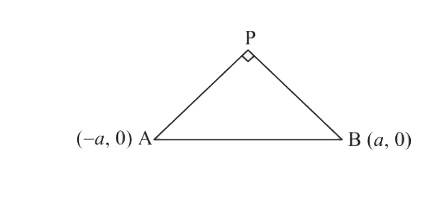A and B are fixed points such that AB=2a. The vertex C of ΔABC such that cotA+cotB=constant. Then locus of C is
straight line perpendicular to AB
straight line parallel to AB
circle
none of these
The correct Answer is:B
To solve the problem, we need to find the locus of point C such that cotA+cotB=constant given that points A and B are fixed and the distance AB=2a.
1. Understanding the Setup:
Let points A and B be fixed points on the coordinate plane. We can place A at (−a,0) and B at (a,0) so that the distance AB=2a.
2. Defining the Triangle:
Let C be a point (x,y) in the plane. We need to analyze the angles A and B in triangle ABC.
3. Using Cotangent Formula:
The cotangent of an angle in a triangle can be expressed in terms of the lengths of the sides. Specifically, for triangle ABC:
cotA=ADCDandcotB=BDCD
where D is the foot of the perpendicular from C to line AB.
4. Finding Lengths:
The lengths can be expressed as follows:
- AD=√(x+a)2+y2
- BD=√(x−a)2+y2
- CD=y (since D lies on the x-axis)
5. Setting Up the Equation:
We can substitute these lengths into the cotangent expressions:
cotA+cotB=√(x+a)2+y2y+√(x−a)2+y2y=constant
Simplifying gives:
√(x+a)2+y2+√(x−a)2+y2y=constant
6. Rearranging the Equation:
Let k be the constant. Then we have:
√(x+a)2+y2+√(x−a)2+y2=k⋅y
7. Analyzing the Locus:
The equation derived indicates that as C moves such that the sum of the distances from A and B remains proportional to the vertical distance (y-coordinate), the locus of C will be a line parallel to the line segment AB.
8. Conclusion:
Therefore, the locus of point C is a straight line parallel to line AB.
Final Answer:
The locus of C is a straight line parallel to AB.
Let points A and B be fixed points on the coordinate plane. We can place A at (−a,0) and B at (a,0) so that the distance AB=2a.
Let C be a point (x,y) in the plane. We need to analyze the angles A and B in triangle ABC.
The cotangent of an angle in a triangle can be expressed in terms of the lengths of the sides. Specifically, for triangle ABC:
cotA=ADCDandcotB=BDCD
where D is the foot of the perpendicular from C to line AB.
The lengths can be expressed as follows:
- AD=√(x+a)2+y2
- BD=√(x−a)2+y2
- CD=y (since D lies on the x-axis)
We can substitute these lengths into the cotangent expressions:
cotA+cotB=√(x+a)2+y2y+√(x−a)2+y2y=constant
Simplifying gives:
√(x+a)2+y2+√(x−a)2+y2y=constant
Let k be the constant. Then we have:
√(x+a)2+y2+√(x−a)2+y2=k⋅y
The equation derived indicates that as C moves such that the sum of the distances from A and B remains proportional to the vertical distance (y-coordinate), the locus of C will be a line parallel to the line segment AB.
Therefore, the locus of point C is a straight line parallel to line AB.
The locus of C is a straight line parallel to AB.
Topper's Solved these Questions
- BOOK - CENGAGE ENGLISHCHAPTER - COORDINATE SYSTEMEXERCISE - Comprehension Type4videos
COORDINATE SYSTEM
- BOOK - CENGAGE ENGLISHCHAPTER - COORDINATE SYSTEMEXERCISE - Multiple Correct Answers Type2videos
COORDINATE SYSTEM
- BOOK - CENGAGE ENGLISHCHAPTER - CONTINUITY AND DIFFERENTIABILITYEXERCISE - Comprehension Type2videos
CONTINUITY AND DIFFERENTIABILITY
- BOOK - CENGAGE ENGLISHCHAPTER - COORDINATE SYSYEM EXERCISE - JEE Main6videos
COORDINATE SYSYEM
Similar Questions
A & B are two fixed points. The vertex C of △ABC moves such that cotA+cotB= constant. The locus of C is a straight line
View SolutionA (c,0) and B (-c,0) are two points . If P is a point such that PA + PB = 2a where 0<c<a, then find the locus of P.
View SolutionThe base AB of a triangle is fixed and its vertex C moves such that sin A =k sin B (k≠1). Show that the locus of C is a circle whose centre lies on the line AB and whose radius is equal to ak(1−k2), a being the length of the base AB.
View SolutionA and B are two fixed points. The locus of a point P such that ∠APB is a right angle, is:
 View Solution
View SolutionGiven two points A and B. If area of triangle ABC is constant then locus of point C in space is
View SolutionIf A+B+C=π2, show that : cotA+cotB+cotC=cotAcotBcotC
View SolutionIn triangle ABC, base BC is fixed. Then prove that the locus of vertex A such that tan B+tan C= Constant is parabola.
View SolutionIf a,b and c are the position vectors of the vertices A,B and C of the ΔABC, then the centroid of ΔABC is
View SolutionBase BC of triangle ABC is fixed and opposite vertex A moves in such a way that tan.B2tan.C2 is constant. Prove that locus of vertex A is ellipse.
View SolutionA variable line intersects the co-ordinate axes at A and B and passes through a fixed point (a,b).then the locus of the vertex C of the rectangle OACB where O is the origin is
View Solution

